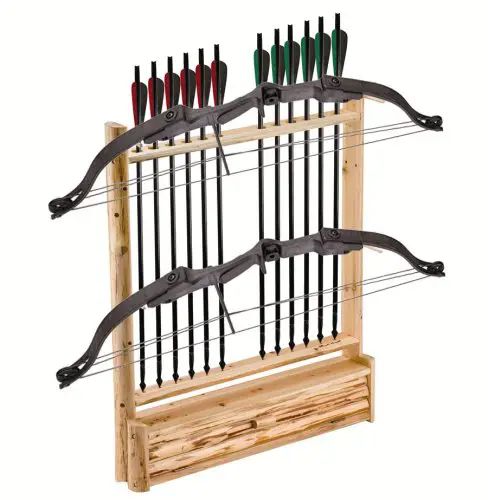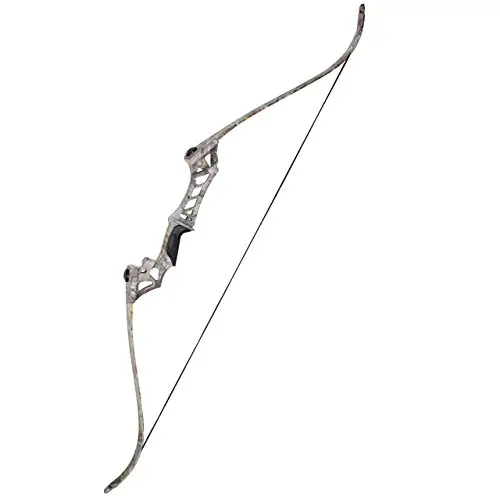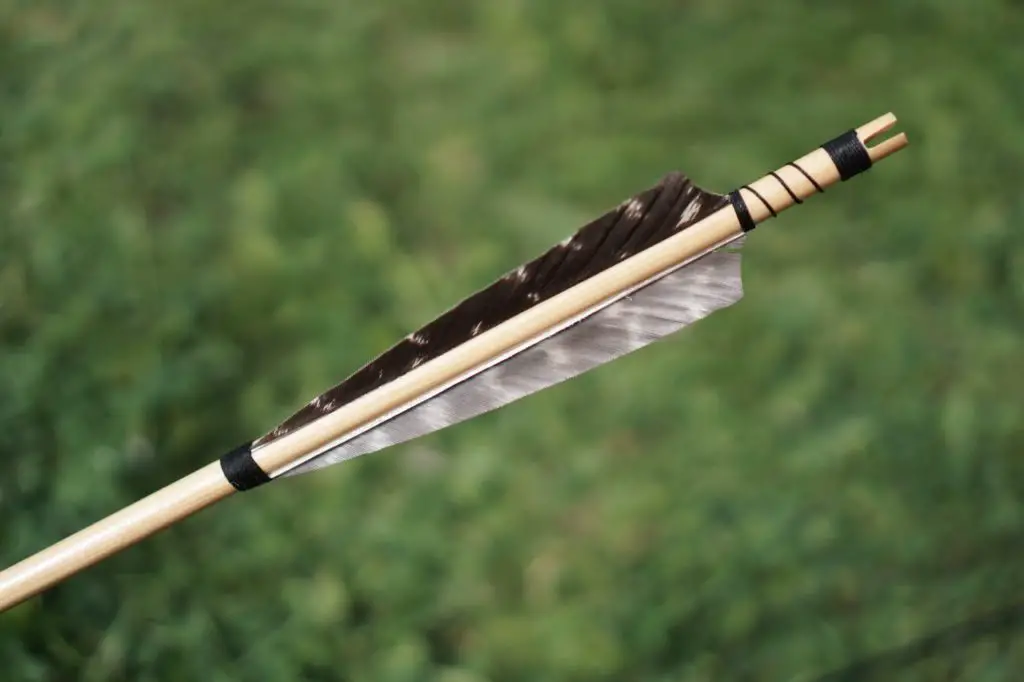Whether you want to get into the sport of archery, or if you want to try hunting with a recurve bow, It’s always a good idea to know as much as you can about the bow as you can. That is probably why you’re here!
We’ve got a lot of ground to cover so we’re just going to dive right in.
Parts Of A Bow
To fully understand what a recurve bow is, you first need to know the parts of the bow:
- Arrow Rest – This is where your arrow will rest during the draw. These could either be a simple fixed rest or could be spring-loaded or magnetic flip rests.
- Back – The back is the part of the bow that is facing the target.
- Belly – The belly is the part that is facing you.
- Bow Sight – An aiming aid that is attached to the riser.
- Brace Height – This is in reference to the distance between the deepest part of the grip and your string. The technical term is fistmele, and it refers to the equivalent length of a closed fist when your thumb is extended, which indicates the correct distance between the deepest part of the grip and the string.
- Grip – This is going to be the part that you hold.
- Limbs – These are the upper and lower parts of the bow that are going to do all the work. These are available in a variety of poundages.
- Nocking Point – This is spot on the string where the nock (end) of the arrow is fitted.
- Riser – This is the rigid center part of the bow where the limbs are attached.
- String – This is the cord that is attached to the limb tips and will be responsible for transforming the energy stored in the limbs into energy that will propel the arrow.
- Sling – The sling is a strap or a cord that is attached to the handle of the bow so that the bow doesn’t fall in your hand while using.
- Tab – The tab or thumb ring, as it is sometimes called, is what will protect your fingers that are drawing the string. It’ll also provide you with better performance when you release the string. These are usually made from a leather material.
- Tiller – The tiller is the difference between the limb-string distances that is measured from where the limbs are attached to the riser. Most of the time, the upper distance is going to be a little more than the bottom, which is called a positive tiller. This will reflect the power balance between the two limbs.

Types Of Bows
In archery, the type of bow is determined when you look at the shape of the bow from the side. There are six types of bows:
- Straight Bows – These bows were used by English archers during the Middle Ages. These bows are typically made from yew and they are long and heavy. Today, their profiles are straight with a minor curve from the natural wood.
- Reflex Bows – A reflex bow is one that has curled arms that turn away from the archer. When the bow is unstrung, the bow will curve away from you so that it looks like a “C.” This is what makes it different than a recurve bow. These bows are still used in Korea and are common in Turkish and Indian traditional archery—you’ll rarely see these bows used while hunting or for war.
- Decurve Bows – These bows have their arms curved at the end toward the archer. This bow is going to reduce the strain on the bow when it is being used and because the bow isn’t going to be under tension when it’s been strung, it will be ready at all times. This bow is rarely used, but it has been known to be used on occasion by the Mohave.
- Deflex Bows – The deflex bow is one where the arms are curved at the base and they turn toward the archer when there is no strong. These bows reduces the strain on the limb and the energy that is stored in the weapon. Sometimes the modern recurve bow will have some type of deflex. Sometimes these are used in traditional bows, such as the traditional longhorn bow, minus the real horn.
- Compound Bows – The compound bow uses a levering system to make the limbs bend. The limbs of this bow is a lot stiffer than a recurve or longbow and that stiffness makes the compound bow more energy efficient than the others.
- Recurve Bows – These bows have tips that will curve away from the archer when the bow doesn’t have a string in it. There are two types of recurves—a one-piece bow that is all one piece, and a collapsible recurve bow (also known as a take-down bow), where the limbs can be detached for its riser, making it a great travel.
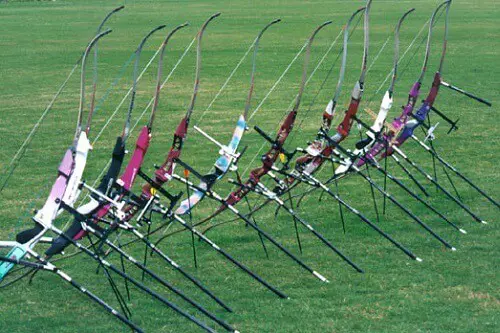
Also, take-downs allow for interchangeability, allowing you to get the perfect bow for you. The modern recurve bow is the only type of bow that is allowed in the Olympics, and these are mostly take-down bows.
Difference Between A Traditional Bow And A Recurve Bow?
When you’re looking for archery recurve bows, you may be wondering to yourself what is the difference between the two types of bows. The short answer is that it’s all a matter of curves and the materials used.
When the traditional longbow bow is unstrung, it is basically a straight wooden pole with a “D” shaped cross section where the flat edge is facing you, the archer. These bows are typically 3-inches longer than the archer is tall.
So, if you’re 6 feet tall, your bow is going to be 6’3”, hence the name. When it’s been strung up, it’ll the on a regular curve toward the archer. The longbow is usually made by using several layers from different types of wood and they are laminated together to create a single save of wood.
These laminated bows are made by using wood that are favorable to compression on the side that faces the archer. These woods are going to also be able to stretch well on the opposite side.
These bows are made to be very strong and can have very high draw weights. There are some longbows that can reach over 180 pounds in draw weight, and these are typically called war-bows.
A modern recurve bow curve away from the archer after the initial longbow curve. These bows typically have an unbending riser and curved limbs.
These bows will also have a window cut into the actual bow so that the arrow will fly straighter through it. This window is going to help the archer achieve maximum accuracy because it’ll allow for you to use a stiffer arrow.
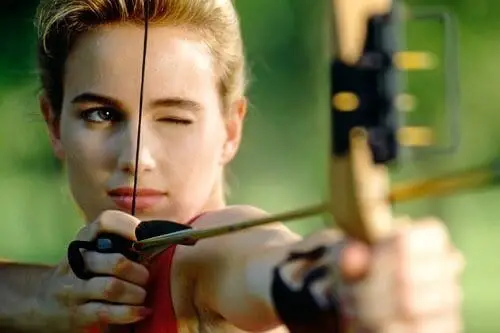
The belief of the re-curving of the limbs is that the very ends of the limbs will be able to accelerate faster than the rest of the limb, thus being able to transfer energy much more efficiently, creating faster arrow speeds and improved accuracy.
The modern recurve bow can be purchased with additional accessories to provide a more consistent shot, but more about them later.
Typical Materials Used To Create A Recurve Bow
Throughout history, the recurve bow was made from composite materials and they were used by the Chinese, Turks, Greeks, and others.
While the limbs are still made from composite materials like fiberglass, carbon and/or wood around a carbon or wood core, the risers are often made from another material, be it wood or plastic, which are ideal for a beginner recurve bow.
But for more advanced bows, you’ll find the risers are made from a carbon fiber or aluminum with carbon fiber.
Carbon Fiber Recurve Bow
Carbon fiber is going to have great strength-to-weight ratio. With carbon fiber risers, there are hollow carbon tubes that are interlocked to give you incredible stiffness, which is engineered to promote near instantaneous vibration damping as it reduces noise significantly.
Also, when you’re using the bow in colder weather, a cold riser will make it harder to get a perfect shot. A carbon fiber riser isn’t going to feel cold—in fact, it may even feel warm when you touch it.Shop Related Products
Fiberglass Recurve Bow
A bow made of fiberglass is generally used because it is stiffer than wood and it’s often a bit more affordable. If you get a and fiberglass sandwiched together, it’s going to provide with high tensile and compression strength, and it’ll also be relatively lightweight.
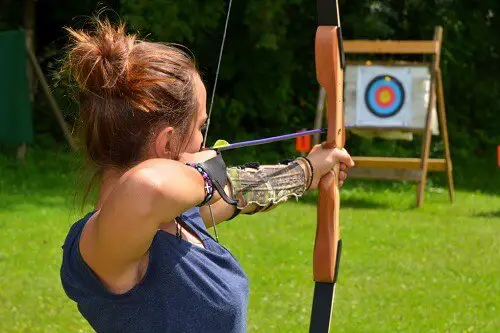
Wood Recurve Bow
A wooden recurve bow will be flexible enough to handle all that bending and the stress that is applied when you shoot your arrow.
Among the types of wood used include: yew, hickory, walnut, ash, and even exotic woods like basswood, yucca, blackwood, and iron wood. However, when it comes to the type of wood used for the core, it is almost always maple—especially in glass-faced and backed bows.
Metal Recurve Bow
Bows that feature a metal riser are going to make the bow heavier and more stable. These risers allow the archer to see the target and get a better shot.
Common Accessories For The Recurve Bow
Now that you know what kinds of bows there are, the difference between a traditional longbow and a recurve bow and the parts of a bow, let’s take a look at some items that are essential if you’re new to archery.
Bow Stringer
The bow stringer is going to be an essential piece of equipment because it is the only way that you can consistently string a bow and be safe.
The stringer will help you to use your body weight to bend your recurve enough so that you can slip your string over the tips of the limbs.
Back in the day, the “step-through” method may have been used, but that can be quite dangerous for both you and your bow. So, always use a stringer!
Arrows
Naturally, if you’re going to have a bow, you’re going to want arrows to go with it! It’s a good idea that when you buy the arrows, you get more than one and purchase them while you are purchasing your bow.
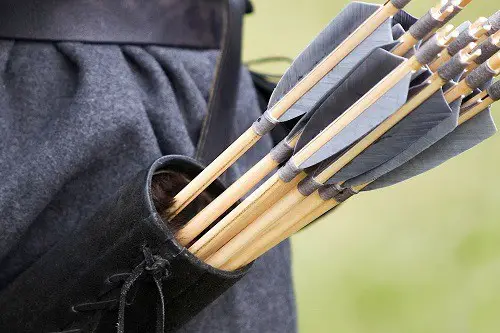
This way the sales associate will be able to recommend the right sized arrows according to your draw length.
Nocking Points
The nock point is going to give you a consistent place on the string to put your arrow. This is going to be important because it’ll give you consistency when you’re shooting and will help your arrow go where you want it to.
Also, it’ll make sure you don’t accidentally hit your bow hand with the arrows vanes or fletchings.
Of course, you can make your own nock points from a brass point, serving strong, or even from a bit of tape. The person who helps you purchase your bow will help you set your nock point to the spot where you need it.
Arm Guards
An arm guard isn’t necessarily a necessity, but it is a recommended accessory. The guard will cover your arm so that nothing is in the way of your bowstring when you release your arrow
Finger Tabs
Sometimes you’re going to need to purchase your own tabs, but as we mentioned above, these tabs will protect your fingers while drawing your string from getting blisters.
Arrow Rest
Another item that isn’t always included when you purchase your bow. While you can use your hand to rest the arrow on, a rest is going to be easier for you to use as become more comfortable with your bow.
Bow String Wax
The wax will prevent the fibers on your string from fraying. It will also protect your string from water and the elements while you are outside.
Sight
Recurve bow sights are designed to help you aim better, but unfortunately not all bows include them.
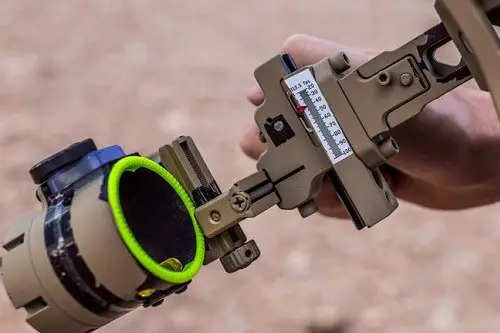
This is because many archers who use the recurve like the challenge of using their instincts to shoot, rather than relying on a guide to help them. However, if you’re a beginner, then you may want to invest in a decent bow sight.
Quiver
If you’ve always fancied being a modern Robin Hood and whipping arrows out from a quiver, now is your chance. The quiver is just a convenient way to carry your arrows and it can be worn on your waist or on the shoulder.
Whisker Silencers
A whisker silencer is a lightweight rubber object that is going to be able to reduce the sound that emanates from your bow string, without compromising how it performs.
These are necessary if you’re just into archery as a hobby, but they are great things to have if you’re in the woods using a hunting recurve bow, and silence is needed. Amazon’s Best Recurve Bow Accessories
How To Choose Your Bow
So… How with so many bows on the market, how do you choose the right one for you? Well…
- You need to decide what you’re going to be using it for, will it be a hunting bow or will it be a competition recurve bow. If you are using it for hunting, your bow will need a higher draw height.
- Choose a good draw weight. This weight will correlate to how much strength you’ll need to pull the back on the string. To pick your ideal draw weight as an adult beginner, you will want to start off between 18 to 24 pounds of draw weight. Children will want to start at a lower weight.
- By choosing a low draw weight, it will result in not having much speed or power when you shoot, but it will allow you to learn the correct technique and form.
- If you’re new to archery, you should always shoot with a lighter bow with regard to your draw weight. You don’t want to choose a bow that is going to be too difficult to draw back.
- Choose a bow length that when it is on the ground, the top limb will end somewhere between your eyebrows. Bows are available in a variety of lengths, and the average person will be able to use a bow that is either 66 inches or 68 inches.
- Decide if you want a collapsible recurve bow. If you do, you’ll want to keep in mind that these bows are designed to be dismantled, which will also make the draw weight flexible. This can be useful because that means you won’t have to purchase another bow if you decide to increase your draw weight. Instead, you can just purchase new limbs.
- Test a few different bows before settling on one. Go to a store where you can have someone help you choose a bow that is going to be best suited for your height, draw strength and your handedness.
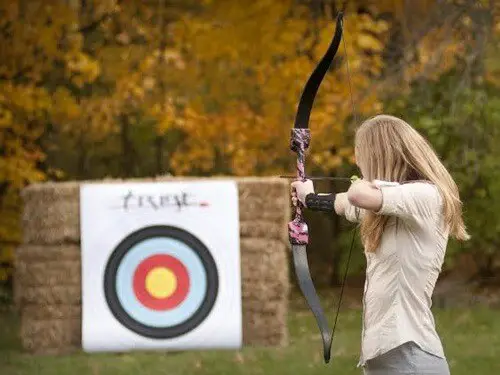
How To Use Your Bow
So, now that you have all the accessories for your bow, you might be wondering how to aim a recurve bow and just how to use it in general.
- You are going to want to have the right stance before you start shooting. When standing perpendicular to the target, your left hip should point to the target if you are right handed (right hip toward the target if you are left handed). Your body shouldn’t be leaning one way or another, keep your body straight.
- Keep your feet planted firmly shoulder-width apart on either side of the shooting line. The shooting line is the line that will mark a particular distance from your target.
- Turn your face toward your target, not your body. You’ll want to keep your chest and shoulders straight and avoid hunching over while you take aim.
- Hold your bow with a comfortable, but firm grip. If you are right handed, the hand grip will be in your left hand.
- Load your arrow in the bow by fitting the notch at the end of the arrow into the bow string. This is called nocking your arrow and you’ll want to do it before you lift your bow or drawing the string.
- Lift your bow so that it is at shoulder height, and keep the elbow straight, as a bent elbow will make it more difficult to draw the bow.
- Pull your string back far enough so that it rests right under your jawbone. The string should almost be touching the skin near the corner of your mouth. Make sure you aren’t twisting at the torso to face your target.
- Use your dominant eye to aim for the target while the other eye is closed.
- Let go of your arrow and watch your arrow fly!

Recurve Bow Wrap Up
Deciding to get into archery can be an exciting time in someone’s life, especially if they have a competitive edge.
While you have many different types of bows that you could choose from, many people prefer a recurve because they offer more stability and consistency than your traditional longbow.
We hope that as you read through our guide, you understand these bows, how to choose one for you, and how to use it. We are certain that once you get that perfect bow, you’re going to love target shooting, be it a target, or if you’re going hunting!
Check Out Our Best Recurve Bows Here!
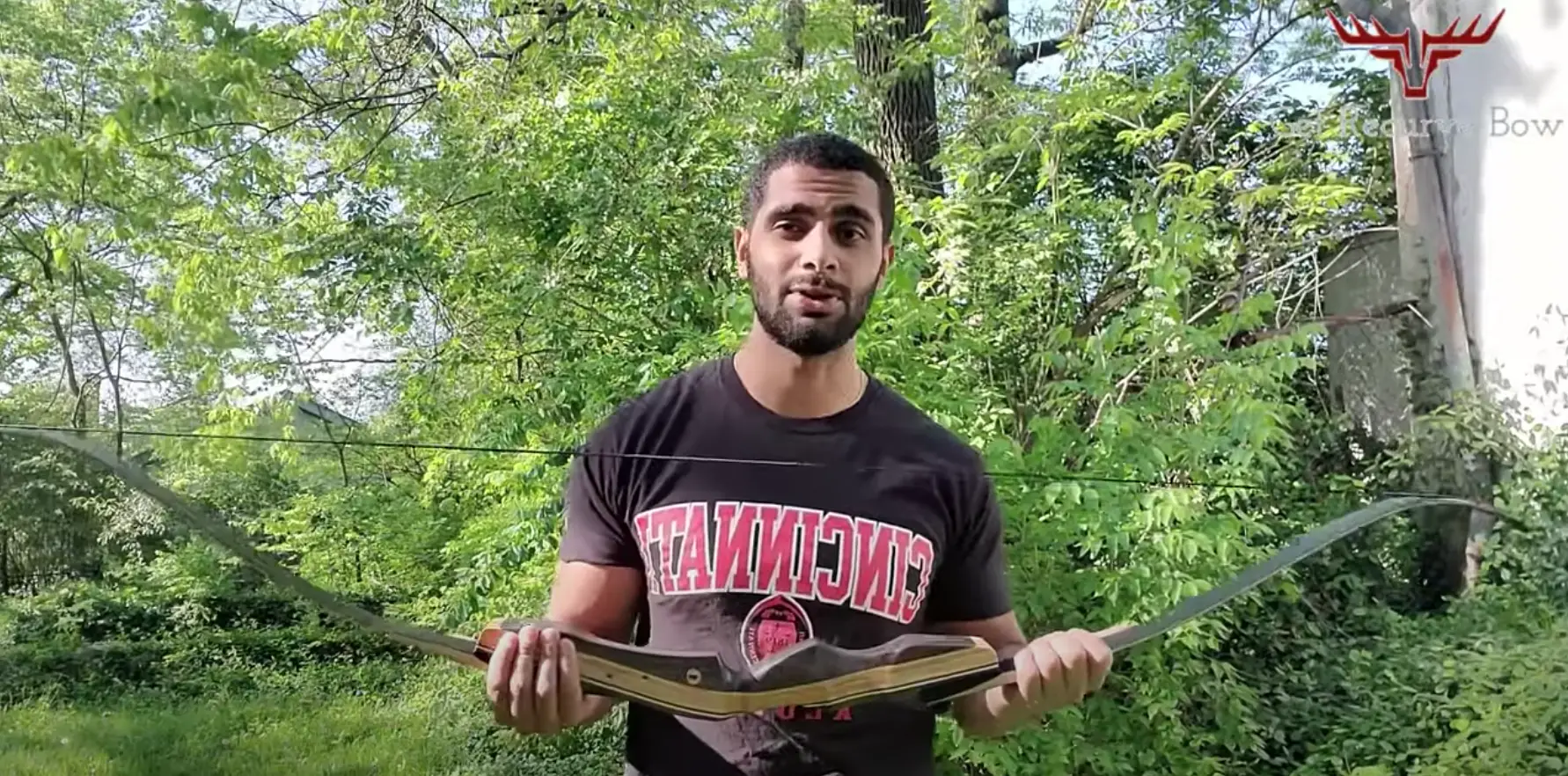
Archery is my hobby & I usually hunt and play on weekends and after work. It’s a passion since I was very young and I love writing about it as well to continuously learn more and share the love of archery with others!

